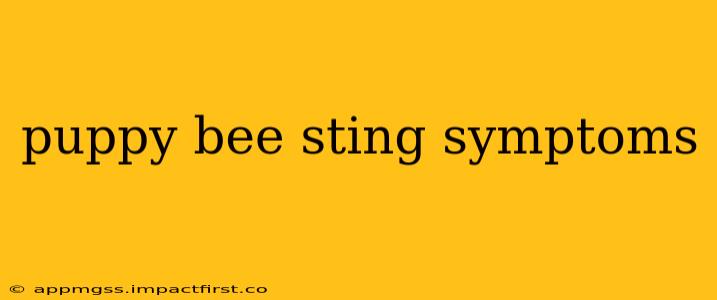Bee stings are a common summertime hazard, and unfortunately, even our furry friends aren't immune. While adult dogs might experience a localized reaction, puppies, with their smaller size and less developed immune systems, can be more vulnerable to severe reactions. Understanding the symptoms of a bee sting in a puppy is crucial for prompt and effective treatment. This guide will help you recognize the signs, provide appropriate first aid, and know when to seek veterinary care.
What are the Symptoms of a Bee Sting in a Puppy?
The initial symptoms of a bee sting in a puppy often mirror those in humans. You'll likely notice immediate localized swelling and redness around the sting site. Your puppy might also exhibit signs of pain, such as whining, yelping, or licking the affected area excessively. However, puppies can react more dramatically than adult dogs due to their sensitivity.
How do I know if my puppy is having a severe allergic reaction?
This is a crucial question, and prompt action is vital. A severe allergic reaction (anaphylaxis) is a life-threatening emergency. Signs of anaphylaxis in a puppy include:
- Swelling beyond the sting site: If swelling spreads rapidly to the face, mouth, throat, or paws, this is a serious warning sign.
- Difficulty breathing: Wheezing, gasping, or rapid breathing indicates respiratory distress.
- Vomiting and diarrhea: These gastrointestinal symptoms, especially when accompanied by other signs, suggest a significant allergic response.
- Collapse or weakness: A sudden loss of energy or collapse warrants immediate veterinary attention.
- Hives or widespread rash: The appearance of hives or a generalized skin rash points to a systemic allergic reaction.
- Pale gums: Pale or bluish gums indicate poor circulation and are a sign of shock.
What if my puppy only has mild symptoms?
If your puppy only displays mild local symptoms like swelling and redness at the sting site, you can usually manage the situation at home. However, monitor your pet closely for any changes.
My puppy got stung, but I don't see a stinger. Is that possible?
Yes, absolutely. While bees leave their stinger behind, wasps and hornets do not. The symptoms are very similar, and treatment remains the same.
What should I do if my puppy gets stung?
First aid for a bee sting in a puppy involves several steps:
- Remove the stinger (if present): Use a credit card or the edge of a knife to scrape the stinger away, avoiding squeezing the venom sac. Tweezers are not recommended as they can release more venom.
- Clean the area: Gently wash the sting site with mild soap and water.
- Apply a cold compress: A cold compress can help reduce swelling and pain.
- Monitor your puppy closely: Observe your puppy for any worsening symptoms, especially those indicative of an allergic reaction.
When should I take my puppy to the vet?
It's crucial to contact your veterinarian immediately if your puppy exhibits any of the severe allergic reaction symptoms listed above. Time is of the essence in treating anaphylaxis, and prompt veterinary care can be lifesaving. Even if the symptoms seem mild initially, it's always best to err on the side of caution and consult your vet if you have any concerns.
How can I prevent bee stings in my puppy?
Prevention is always better than cure. Here are some tips to minimize the risk of bee stings:
- Supervise your puppy outdoors: Keep a close eye on your puppy, especially in areas known to have bees or wasps.
- Avoid areas with high bee activity: Stay away from flowering plants, garbage cans, and areas with standing water, as these attract bees.
- Teach your puppy "leave it": Train your puppy to avoid approaching insects.
- Keep your yard clean: Remove any potential attractants, like spilled food or sugary drinks.
Remember, a bee sting in a puppy can range from a minor inconvenience to a life-threatening emergency. By understanding the symptoms and knowing when to seek veterinary attention, you can ensure the safety and well-being of your beloved companion. Always consult your veterinarian for any concerns about your pet's health.
